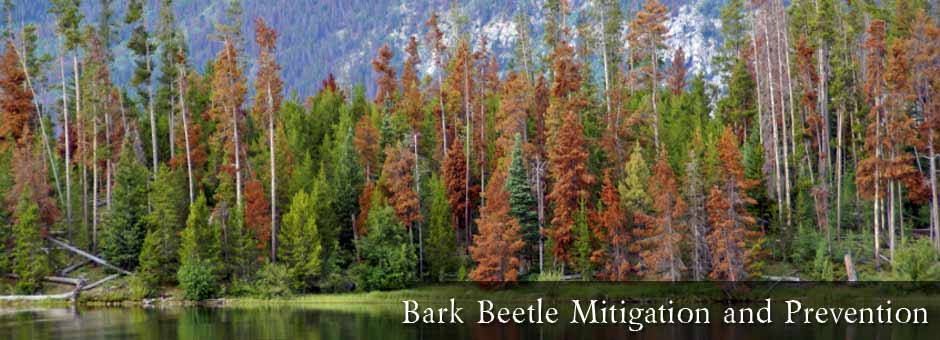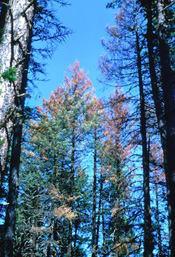 Recognizing the signs of beetle infestation in your trees is an important consideration when living within the forest. A tree that appears to be perfectly healthy with green needles may also be infested. Once a tree has been successfully “mass attacked” by beetles, the tree will die. The tree can remain green for 12 months or longer after a successful beetle attack. By summer to fall of the following year after the attack, the tree will start to flag; showing signs of health decline.
Recognizing the signs of beetle infestation in your trees is an important consideration when living within the forest. A tree that appears to be perfectly healthy with green needles may also be infested. Once a tree has been successfully “mass attacked” by beetles, the tree will die. The tree can remain green for 12 months or longer after a successful beetle attack. By summer to fall of the following year after the attack, the tree will start to flag; showing signs of health decline.
Flagging is the term given to the process of the tree’s needles turning from green, to yellow, to red. It is best to assess whether or not your trees have been attacked by beetles in the late summer/early fall immediately following beetle flight.
Determining whether the attacks have been successful can be difficult. Some foresters believe that 40 successful attacks per square yard will be fatal to the tree. At times, blind attacks occur, which are almost impossible to observe. It is important to note that when the first few beetles successfully attack a tree, they will emit a pheromone that will attract more beetles into the area, and into that host tree.
For every beetle that mates inside your tree, it is estimated that up to 60 new generation beetles will emerge in the following season. Even lightly attacked trees may succumb to further beetle attack in the following year as these trees can serve as an attractant to beetles due to a stress increase to the tree.
Prevention is the most important part of any beetle management strategy. Early prevention through silvicultural methods as well as direct control/suppression efforts are effective options for controlling bark beetles in your forest.
What Should You Look For in Determining Whether There are Beetles In Your Forest:
Pitch Tubes:The first signs of attack are whitish globs that look like popcorn on the side of the tree’s trunk. These signs are are called pitch tubes. Pitch tubes are a defense mechanism of the tree that serves to expel the beetle from the tree’s phloem layer. The tree’s production of resin can “pitch out” beetles as they bore into the bark. Large pitch tubes often indicate unsuccessful attacks while very small pitch tubes or no pitch tubes at all may indicate successful attacks. Look carefully within the pith tube and you will likely find a beetle inside of the sappy glob. Boring Dust:Small mounds of ‘sawdust’ at the base of the tree and in the bark crevice. Boring dust is left when the beetles bore into the bark of the tree. This will have the consistency of flour or fine sawdust and will be reddish in color. Bark:Remove a section of the bark to reveal any galleries (tunnels) created by the beetles. Galleries indicate a successful attack. At times these galleries will also contain grubs. Use this method carefully as this will injure the tree and leave it more susceptible. Woodpeckers:Woodpeckers find the larvae of the beetle particularly appetizing. An abundance of these woodpecker holes can be a good indication of tree infestation. Blue Stain:Beetles bring with them a fungus called ‘Blue Stain’. A tree with blue stain fungus is a clear sign of beetle attack; but unfortunately this fungus is only visible when the tree is cut. NOTE: Beetles prefer to bore into a tree where the bark is the thinnest, namely in the cracks and crevasses. This can make it very difficult to determine the number of beetle hits, and whether or not the hits were successful. |
|
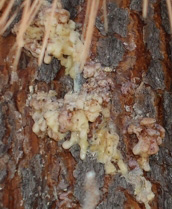 Pitch Tubes |
|
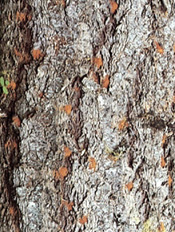 Boring Dust May Litter the Ground |
|
 Woodpecker Damage |
|
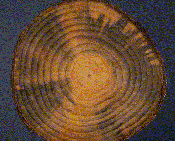 Blue Stain Fungus |
Click for Bark Beetle Prevention Strategies
Life Cycle of the Mountain Pine Beetle
Mountain Pine Beetles (MPB) normally have a one-year life cycle but in colder climates and in higher elevations they have the potential to over winter and adapt to a two or three year life cycle. In the event that the beetle’s life cycle is greater than one year, the beetles will still produce only one brood. This indicates that the beetles can adapt to climate changes in order to survive.
Beetle flight is climate dependent as well as elevation dependent. Specific areas may vary, but it is in late summer (in general) when adult females emerge. This will occur when ambient air temperature exceeds approximately 16ºC or 61ºF. The adults are about about 5 mm (1/4″) long when they bore out through the bark and fly away from the pine tree in which they matured over the previous 12 months.
The emerging beetles fly through the forest seeking an acceptable host in which they will mate and create a future brood. The dynamics of flight and the determination of an acceptable host is a topic in and of itself. When the female pioneer beetle begins burrowing into a suitable host tree, she releases an attractive aggregation pheromone that attracts both males and females. A mass attack weakens the trees making it easier for beetles to overcome the trees natural defense of pitching the beetles out.
The female beetles tunnel into pine trees and lay eggs in vertical galleries under the bark. In the galleries, females mate with males and lay eggs individually along the sides of the gallery. Female MPBs will lay approximately 60 eggs.
After about two weeks, the eggs hatch and the grub-like larvae make horizontal galleries within the phloem layer of the tree, and the larvae over-winter under the protective bark of the tree. The larvae resume feeding in spring and grow up to 7 mm in length. They can resist -35° temperatures multiple days in the winter months. Larvae pupate in the spring and emerge as adults from July to September.
Part of the destructiveness of MPB is the transmission of blue-stain fungi from the beetle to the tree. The spores of these fungi are brought into the tree by adult beetles during colonization. Together with feeding beetles, fungus grows within the tree, weakening and eventually killing the tree. This mutual network of beetle galleries and blue stain fungi impedes the movement of water within the tree and as a result, there is rapid tree decline. The fungi give a blue-grey appearance to the sapwood.
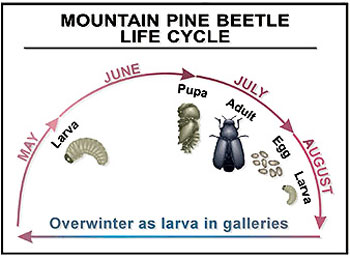
Mountain Pine Beetle Lifecycle
Click for Bark Beetle Prevention Strategies
Life Cycle of the Douglas-fir Beetle
Douglas-fir beetles typically take one year to complete their life cycle. Over-wintering takes place beneath the bark of the tree in which they matured for the previous 12 months. Adults emerge from their host tree and infest susceptible trees typically during late April to mid-June when ambient air temperature exceeds approximately 18ºC or 64ºF. A small percentage of beetles may over winter as larvae. Beetles that have survived the winter as larvae complete their development in spring and early summer. They emerge and attack host trees in midsummer. In addition, a few adults who made initial attacks in the spring may re-emerge to make a second attack in mid to late summer. This “second flight” usually accounts for less than ten percent of the yearly total of attacked trees. Often, these later attacks are concentrated within trees which were previously attacked during the initial spring flight.
Attacks are initiated by female beetles when they bore through the bark and release an aggregate pheromone to attract other female and male beetles that are migrating through the forest. Once the female has attracted a male and mated, she constructs a vertical egg gallery beneath the tree’s bark, paralleling the grain of the wood. Eggs hatch within approximately one week and larvae begin feeding at right angles to the egg gallery, starting within the inner bark (phloem). As they mature toward mid-to-late August, they feed more deeply into the bark and grow to 6 mm long. At that point, they construct pupal chambers, pupate, and complete their development by late summer or early autumn. Newly matured adults remain beneath the bark until the following spring when they emerge to make new attacks and renew the yearly cycle.
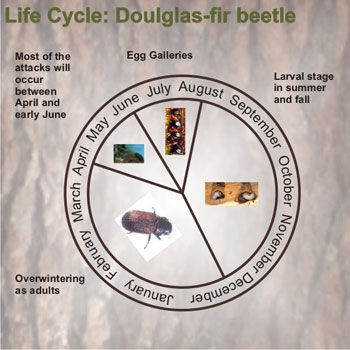
Douglas-fir Beetle Lifecycle
